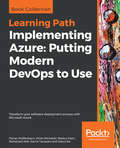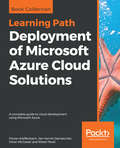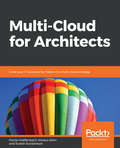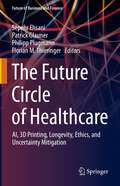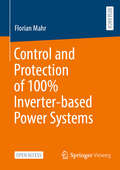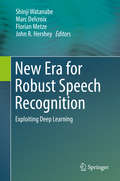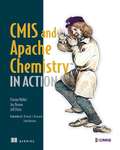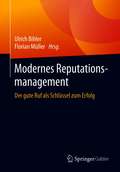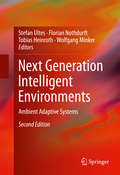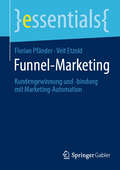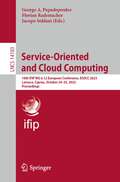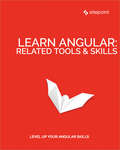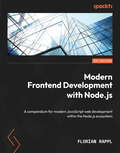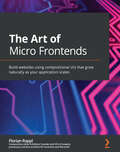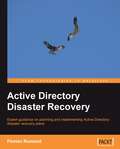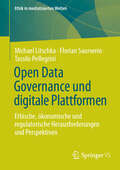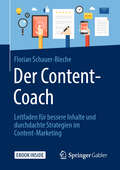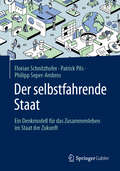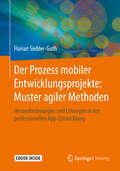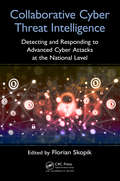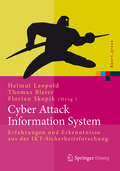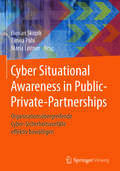- Table View
- List View
Implementing Azure: Transform your software deployment process with Microsoft Azure
by Florian Klaffenbach Oliver Michalski Namit Tanasseri Markus Klein Mohamed WaliExplore powerful Azure DevOps solutions to develop and deploy your software faster and more efficiently. Key Features Build modern microservice-based systems with Azure architecture Learn to deploy and manage cloud services and virtual machines Configure clusters with Azure Service Fabric for deployment Book Description This Learning Path helps you understand microservices architecture and leverage various services of Microsoft Azure Service Fabric to build, deploy, and maintain highly scalable enterprise-grade applications. You will learn to select an appropriate Azure backend structure for your solutions and work with its toolkit and managed apps to share your solutions with its service catalog. As you progress through the Learning Path, you will study Azure Cloud Services, Azure-managed Kubernetes, and Azure Container Services deployment techniques. To apply all that you've understood, you will build an end-to-end Azure system in scalable, decoupled tiers for an industrial bakery with three business domains. Toward the end of this Learning Path, you will build another scalable architecture using Azure Service Bus topics to send orders between decoupled business domains with scalable worker roles processing these orders. By the end of this Learning Path, you will be comfortable in using development, deployment, and maintenance processes to build robust cloud solutions on Azure. This Learning Path includes content from the following Packt products: Learn Microsoft Azure by Mohamed Wali Implementing Azure Solutions - Second Edition by Florian Klaffenbach, Oliver Michalski, Markus Klein Microservices with Azure by Namit Tanasseri and Rahul Rai What you will learn Study various Azure Service Fabric application programming models Create and manage a Kubernetes cluster in Azure Kubernetes Service Use site-to-site VPN and ExpressRoute connections in your environment Design an Azure IoT app and learn to operate it in various scenarios Implement a hybrid Azure design using Azure Stack Build Azure SQL databases with Code First Migrations Integrate client applications with Web API and SignalR on Azure Implement the Azure Active Directory (Azure AD) across the entire system Who this book is for If you are an IT system architect, network admin, or a DevOps engineer who wants to implement Azure solutions for your organization, this Learning Path is for you. Basic knowledge of the Azure Cloud platform will be beneficial.
Learning Path - Deploying Azure Solutions: A Complete Guide To Cloud Development Using Microsoft Azure
by Ritesh Modi Florian Klaffenbach Jan-Henrik Damaschke Oliver MichalskiDeploying Azure Solutions is for IT architects, system and network admins, and DevOps engineers who are aware of Azure solutions and want to implement them for their organization. Prior basic knowledge of the Azure Cloud platform is good to have.
Multi-Cloud for Architects: Grow your IT business by means of a multi-cloud strategy
by Florian Klaffenbach Markus Klein Suresh SundaresanYour one-stop guide to work with multiple cloud service providers Key Features A practical step-by-step guide that will teach you to architect effective Cloud computing solutions and services efficiently You will learn the key differences in both platforms and how you can interconnect them to each other Eliminate the pain-points of architecting, interconnect and managing multi-cloud services and solutions. Book Description With the passing of time and with technology evolving, organizations all around the globe, from small- to medium-sized enterprises through to companies that are fully equipped, have started migrating or adapting to cloud computing. If you are looking at adapting entirely to any cloud and its services, this book will be your go-to guide to find perfect solutions, irrespective of the size of your infrastructure. This book will teach you effective solutions for overcoming various implementation scenarios. Our book covers two major cloud platforms (AWS and Azure) and provides practical use cases. You will start by designing the building blocks for infrastructure solutions that will involve core cloud platform services, such as compute, networking, storage, and identity, through various cloud providers. You will be able to plan and design solutions across major cloud providers and streamline interconnections and identities. Finally, you will understand the differences between, and the behavior of, both platforms, and you will be able to plan interconnects and identities for single-instance management. By the end of this book, you will know everything you need in order to be able to architect a multi-cloud solution for your organization. What you will learn Get to grips with different cloud offerings according to service and availability model Choose your cloud model, depending on real-world requirements Become familiar with interconnecting and designing multi-cloud solutions according to network, identity, and application Interconnect major cloud providers and frameworks, such as Microsoft Azure/Azure Stack, and AWS, and manage hosting solutions Resolve key show stoppers in a multi-cloud environment Familiarize yourself with example architectures based on real-world projects and solutions Who this book is for If you are a Cloud Architect, Solutions architect, system/network administrator, or a DevOps engineers aware of Cloud solutions and keen to successfully architect them to your organization then, this book is for you.
The Future Circle of Healthcare: AI, 3D Printing, Longevity, Ethics, and Uncertainty Mitigation (Future of Business and Finance)
by Philipp Plugmann Patrick Glauner Sepehr Ehsani Florian M. ThieringerThe past decade has brought to the fore the critical need to constantly envision and consider various scenarios where ongoing trends and sudden changes could together alter the provision of healthcare and the direction of medical research. This book brings together scholars whose areas of expertise represent different themes that are essential to understanding how healthcare might change and evolve over the next decade. What lessons can one take away from current and past developments? The themes explored by the book rest on four pillars. The first is the rapid pace and ubiquity of technological advances in areas such as artificial intelligence, machine learning, additive manufacturing and wearable electronics. The second pillar concerns healthy aging, longevity and the management of chronic diseases. The third is the imperative to remain cognizant of the ethical dimensions of medical decisions, adapting bioethics to ongoing changes in healthcare provision. Finally, the fourth pillar relates to how uncertainty in different domains of medical knowledge can be mitigated and translated into clinical practice. For example, how should uncertainty with the results of clinical trials for a new treatment be dealt with? What cost-benefit analyses would be most appropriate for the situation? Chapter authors identify respective challenges and promising opportunities, discussing how these could contribute to envisioning the future scope of healthcare when it comes to providing medical, economic and ethical values to human societies.Chapters 1, 4, 12, and 20 are available open access under a Creative Commons Attribution 4.0 International License via link.springer.com.
Control and Protection of 100% Inverter-based Power Systems
by Florian MahrIn this Open-Access book, voltage source converters (VSCs) as key components of sustainable energy systems based on wind power plants, photovoltaic power plants, battery energy systems, electric vehicles and heat pumps are investigated. In the future, 100% inverter-based power systems (IBPS) will arise. Protective systems against grid faults are a substantial part of electrical grids. They prevent danger to living beings and damage to technical equipment caused by grid faults. The control algorithms of VSCs and protection algorithms must collaborate in future grids. Otherwise, the reliability of energy supply is at risk. Today, control and protection are often regarded independently of each other. In this book, they are investigated mutually. The resilience of the system against grid faults is increased by using flexibility options of VSCs. A universal protection algorithm, which does not restrict these flexibility options, is developed. In this book, post-fault characteristics of VSCs, neutral point treatment and resonant grounding via VSCs and a model-based protection algorithm are presented. The sustainable and reliable energy supply is an essential cornerstone of human societies. This book is pointing out a holistic approach for the control and protection of 100% IBPS contributes along this way.
New Era for Robust Speech Recognition
by Shinji Watanabe Marc Delcroix Florian Metze John R. HersheyThis book covers the state-of-the-art in deep neural-network-based methods for noise robustness in distant speech recognition applications. It provides insights and detailed descriptions of some of the new concepts and key technologies in the field, including novel architectures for speech enhancement, microphone arrays, robust features, acoustic model adaptation, training data augmentation, and training criteria. The contributed chapters also include descriptions of real-world applications, benchmark tools and datasets widely used in the field. This book is intended for researchers and practitioners working in the field of speech processing and recognition who are interested in the latest deep learning techniques for noise robustness. It will also be of interest to graduate students in electrical engineering or computer science, who will find it a useful guide to this field of research.
CMIS and Apache Chemistry in Action
by Jeff Potts Jay Brown Florian MuellerSummaryCMIS and Apache Chemistry in Action is a comprehensive guide to the CMIS standard and related ECM concepts, written by the authors of the standard. In it, you'll tackle hands-on examples for building applications on CMIS repositories from both the client and the server sides. You'll learn how to create new content-centric applications that install and run in any CMIS-compliant repository.About The TechnologyContent Management Interoperability Services (CMIS) is an OASIS standard for accessing content management systems. It specifies a vendor-and language-neutral way to interact with any compliant content repository. Apache Chemistry provides complete reference implementations of the CMIS standard with robust APIs for developers writing tools, applications, and servers.About This BookCMIS and Apache Chemistry in Action is a comprehensive guide to the CMIS standard and related ECM concepts. In it, you'll find clear teaching and instantly useful examples for building content-centric client and server-side applications that run against any CMIS-compliant repository. In fact, using the CMIS Workbench and the InMemory Repository from Apache Chemistry, you'll have running code talking to a real CMIS server by the end of chapter 1.This book requires some familiarity with content management systems and a standard programming language like Java or C#. No exposure to CMIS or Apache Chemistry is assumed.Purchase of the print book includes a free eBook in PDF, Kindle, and ePub formats from Manning Publications.What's InsideThe only CMIS book endorsed by OASISComplete coverage of the CMIS 1.0 and 1.1 specificationsCookbook-style tutorials and real-world examplesAbout the AuthorsFlorian Müller, Jay Brown, and Jeff Potts are among the original authors, contributors, and leaders of Apache Chemistry and the OASIS CMIS specification. They continue to shape CMIS implementations at Alfresco, IBM, and SAP.Table of ContentsPART 1 UNDERSTANDING CMISIntroducing CMISExploring the CMIS domain modelCreating, updating, and deleting objects with CMISCMIS metadata: types and propertiesQueryPART 2 HANDS-ON CMIS CLIENT DEVELOPMENTMeet your new project: The BlendThe Blend: read and query functionalityThe Blend: create, update, and delete functionalityUsing other client librariesBuilding mobile apps with CMISPART 3 ADVANCED TOPICSCMIS bindingsSecurity and controlPerformanceBuilding a CMIS server
Modernes Reputationsmanagement: Der gute Ruf als Schlüssel zum Erfolg
by Ulrich Bihler Florian MüllerDieses Buch erklärt, wie modernes Reputationsmanagement von Unternehmen und Organisationen erfolgreich und nachhaltig gestaltet werden kann – insbesondere in volatilen Zeiten des digitalen und gesellschaftlichen Wandels. Emotionale Aspekte und vor allem die Frage, wofür ein Unternehmen steht und eintritt, spielen eine immer wichtigere Rolle – zum Beispiel bei der Kaufentscheidung des Kunden. Die Reputation eines Unternehmens als immaterieller Vermögenswert bestimmt damit maßgeblich den Erfolg und muss bei allen unternehmerischen Herausforderungen professionell, integriert und zielorientiert gemanagt werden. Die Beitragsautoren erläutern grundlegende Funktionsweisen von Unternehmensreputation sowie die Wirkmechanismen von Issues und Public Affairs Management für einen guten Ruf. Sie zeigen auf, wie beispielsweise Predictive Analytics, Purpose, Thought-Leadership-Strategien oder multisensuale Stakeholderkommunikation einen dringend notwendigen Perspektivwechsel herbeiführen und wie Interne Kommunikation sowie CEO-Kommunikation einen ganzheitlichen Reputationsansatz unterstützen können.Ein Buch voller überraschender Perspektiven, neuer Zusammenhänge, interessanter Insights und hilfreicher Praxistipps.
Research and Education in Urban History in the Age of Digital Libraries: Second International Workshop, UHDL 2019, Dresden, Germany, October 10–11, 2019, Revised Selected Papers (Communications in Computer and Information Science #1501)
by Sander Münster Florian Niebling Heike MessemerThis book constitutes selected and revised papers from the Second International Conference on Research and Education in Urban History in the Age of Digital Libraries, UHDL 2019, held in Dresden, Germany, in October 2021. The 11 full papers presented in this volume were thoroughly reviewed and selected from 41 submissions. They are organized in the topical sections on theory, methods and systematization; visualization and presentation; machine learning and artificial intelligence.- policies, legislation and standards.
Next Generation Intelligent Environments
by Wolfgang Minker Tobias Heinroth Stefan Ultes Florian NothdurftThis book covers key topics in the field of intelligent ambient adaptivesystems. It focuses on the results worked out within the framework of theATRACO (Adaptive and TRusted Ambient eCOlogies) project. The theoreticalbackground, the developed prototypes, and the evaluated results form a fertileground useful for the broad intelligent environments scientific community aswell as for industrial interest groups. The new edition provides: Chapter authors comment on their work on ATRACO with final remarks as viewed in retrospective Each chapter has been updated with follow-up work emerging from ATRACO An extensive introduction to state-of-the-art statistical dialog management for intelligent environments Approaches are introduced on how Trust is reflected during the dialog with the system
Funnel-Marketing: Kundengewinnung und -bindung mit Marketing-Automation (essentials)
by Veit Etzold Florian PfänderDieses essential bietet eine fundierte und kompakte Einführung in die Welt des Funnel-Marketings und zeigt, wie Unternehmen durch Marketing-Automation ihre Zielgruppen gezielt und personalisiert ansprechen können. Die Autoren erläutern Techniken und Strategien für erfolgreiches digitales Marketing und bieten wertvolle Impulse für eine kontinuierliche Optimierung der Customer Journey.Florian Pfänder, B.A., und Prof. Dr. Veit Etzold bündeln ihre Expertise in Marketing und Vertrieb und erklären praxisnah, welche Chancen das Funnel-Marketing für Ihr Unternehmen bietet und wie Sie typische Fehler vermeiden. Schwerpunkte sind u.a. effektive Leadgenerierung und -bewertung, Personalisierung in der Marketing-Automation, die Steigerung der Konversionsrate und Content-Marketing. Ein Buch für alle Marketingfachleute, Vertriebsleiter und Unternehmer, die ihre Kundengewinnung optimieren und langfristige Kundenbeziehungen aufbauen wollen.
Service-Oriented and Cloud Computing: 10th IFIP WG 6.12 European Conference, ESOCC 2023, Larnaca, Cyprus, October 24–25, 2023, Proceedings (Lecture Notes in Computer Science #14183)
by George A. Papadopoulos Jacopo Soldani Florian RademacherThis book constitutes the constitutes the refereed proceedings of the 10th IFIP WG 6.12 European Conference on Service-Oriented and Cloud Computing , ESOCC 2023, held in Larnaca, Cyprus, during October 24–26, 2023. The 12 full papers and 4 short papers included in this book were carefully reviewed and selected from 40 submissions. They were organized in topical sections as follows: Microservices; Quality of Service; Service Orchestration; Edge Computing; PhD Symposium; and Industry Projects Track.
Learn Angular: Related Tool & Skills
by Jeff Smith Michael Wanyoike Ilya Bodrov-Krukowski Jurgen van de Moere Florian Rappl Todd MottoAngular is not just a framework, but rather a platform that empowers developers to build applications for the web, mobile, and the desktop. This book provides an overview of some essential Angular tools--such as Angular CLI, Angular Augary, and Sublime Text--as well as outlining some must-have TypeScript tips. This book is for all front-end developers who want to become proficient with Angular and its related tools. You'll need to be familiar with HTML and CSS and have a reasonable level of understanding of JavaScript in order to follow the discussion.
Modern Frontend Development with Node.js: A compendium for modern JavaScript web development within the Node.js ecosystem
by Florian RapplEnhance your web development projects by fully leveraging Node.js concepts, tools, and best practices at frontendKey FeaturesDiscover the internals of Node.js, focusing on frontend web developmentExplore the npm frontend ecosystem, including its tooling, usage, and development processesLearn about key web development concepts such as monorepos or publishing librariesBook DescriptionAlmost a decade after the release of Node.js, the tooling used by frontend developers is fully embracing this cross-platform JavaScript runtime, which is sadly often limited to server-side web development. This is where this Node.js book comes in, showing you what this popular runtime has to offer and how you can unlock its full potential to create frontend-focused web apps.You'll begin by learning the basics and internals of Node.js, before discovering how to divide your code into modules and packages. Next, you'll get to grips with the most popular package managers and their uses and find out how to use TypeScript and other JavaScript variants with Node.js. Knowing which tool to use when is crucial, so this book helps you understand all the available state-of-the-art tools in Node.js. You'll interact with linters such as ESLint and formatters such as Prettier. As you advance, you'll become well-versed with the Swiss Army Knife for frontend developers – the bundler. You'll also explore various testing utilities, such as Jest, for code quality verification. Finally, you'll be able to publish your code in reusable packages with ease.By the end of this web development book, you'll have gained the knowledge to confidently choose the right code structure for your repositories with all that you've learned about monorepos.What you will learnDevelop a frontend application with Node.js-based tools and librariesUse bundlers such as webpack or Vite to create efficient web applicationsLeverage test runners such as Jest to ship reliable softwareOrganize code repositories to work in close collaboration with other developers and teamsFind out how to publish npm packages to simplify code reuseImprove code quality by enabling consistent formatting using PrettierWho this book is forThis book is for junior and intermediate-level frontend web developers who are looking to leverage the Node.js ecosystem for building frontend solutions. The book requires beginner-level knowledge of JavaScript, HTML, and CSS. Prior experience in using a standard shell (sh) will be beneficial.
The Art of Micro Frontends: Build websites using compositional UIs that grow naturally as your application scales
by Florian Rappl Lothar SchottnerApply your experience of web development with HTML and JavaScript to build micro frontends for large-scale web projects using frameworks such as React and popular web tooling such as Node.js with Express or webpackKey FeaturesCut through the complexities of designing a monolithic web architecture using micro frontend architectureExplore architecture patterns for building large-scale applicationsLearn how to build, test, and secure your micro frontends efficientlyBook DescriptionMicro frontend is a web architecture for frontend development borrowed from the idea of microservices in software development, where each module of the frontend is developed and shipped in isolation to avoid complexity and a single point of failure for your frontend. Complete with hands-on tutorials, projects, and self-assessment questions, this easy-to-follow guide will take you through the patterns available for implementing a micro frontend solution. You'll learn about micro frontends in general, the different architecture styles and their areas of use, how to prepare teams for the change to micro frontends, as well as how to adjust the UI design for scalability. Starting with the simplest variants of micro frontend architectures, the book progresses from static approaches to fully dynamic solutions that allow maximum scalability with faster release cycles. In the concluding chapters, you'll reinforce the knowledge you've gained by working on different case studies relating to micro frontends. By the end of this book, you'll be able to decide if and how micro frontends should be implemented to achieve scalability for your user interface (UI).What you will learnUnderstand how to choose the right micro frontend architectureDesign screens for compositional UIsCreate a great developer experience for micro frontend solutionsAchieve enhanced user experiences with micro frontendsIntroduce governance and boundary checks for managing distributed frontendsBuild scalable modular web applications from scratch or by migrating an existing monolithWho this book is forThis book is for software/solution architects or (mostly lead) developers as well as web developers and frontend engineers. Beginner-level knowledge of HTML and CSS along with a solid understanding of JavaScript programming and its ecosystem, including Node.js and NPM, is assumed.
The Art of Micro Frontends: Build websites using compositional UIs that grow naturally as your application scales
by Florian RapplApply your experience of web development with HTML and JavaScript to build micro frontends for large-scale web projects using frameworks such as React and popular web tooling such as Node.js with Express or webpackKey FeaturesCut through the complexities of designing a monolithic web architecture using micro frontend architectureExplore architecture patterns for building large-scale applicationsLearn how to build, test, and secure your micro frontends efficientlyBook DescriptionMicro frontend is a web architecture for frontend development borrowed from the idea of microservices in software development, where each module of the frontend is developed and shipped in isolation to avoid complexity and a single point of failure for your frontend. Complete with hands-on tutorials, projects, and self-assessment questions, this easy-to-follow guide will take you through the patterns available for implementing a micro frontend solution. You’ll learn about micro frontends in general, the different architecture styles and their areas of use, how to prepare teams for the change to micro frontends, as well as how to adjust the UI design for scalability. Starting with the simplest variants of micro frontend architectures, the book progresses from static approaches to fully dynamic solutions that allow maximum scalability with faster release cycles. In the concluding chapters, you'll reinforce the knowledge you’ve gained by working on different case studies relating to micro frontends. By the end of this book, you'll be able to decide if and how micro frontends should be implemented to achieve scalability for your user interface (UI).What you will learnUnderstand how to choose the right micro frontend architectureDesign screens for compositional UIsCreate a great developer experience for micro frontend solutionsAchieve enhanced user experiences with micro frontendsIntroduce governance and boundary checks for managing distributed frontendsBuild scalable modular web applications from scratch or by migrating an existing monolithWho this book is forThis book is for software/solution architects or (mostly lead) developers as well as web developers and frontend engineers. Beginner-level knowledge of HTML and CSS along with a solid understanding of JavaScript programming and its ecosystem, including Node.js and NPM, is assumed.
Active Directory Disaster Recovery
by Florian RommelThe book is a combined planning/response-focused book and can be read end to end but also is designed so that the second half can be read standalone, should disaster have struck already. This book is targeted at network security professionals who find themselves charged with creating an Active Directory Disaster Recovery plan or who want to quickly recover once disaster has struck. This book expects you to be familiar with the basics of Active Directory and Windows Servers.
Open Data Governance und digitale Plattformen: Ethische, ökonomische und regulatorische Herausforderungen und Perspektiven (Ethik in mediatisierten Welten)
by Tassilo Pellegrini Michael Litschka Florian SaurweinDieses Buch behandelt ethische, ökonomische und regulatorische Aspekte der Open Data Governance bei digitalen Plattformen. Wie Unternehmen der digitalen Ökonomie mit offenen Daten umgehen, wirft viele gesellschaftlich relevante Fragen auf: Wie können offene Daten und der darauf beruhende Content möglichst weit in der Bevölkerung verbreitet werden? Wie kann Content Moderation transparent organisiert und wie können Dateninfrastrukturen sozial erwünscht gestaltet werden? Das Buch analysiert die Fallstudien offene digitale Public-Value Plattformen, offene digitale Dateninfrastrukturen und Content Moderation und Kuratierung auf digitalen Plattformen und entwickelt Governance-Modelle, die eine Beurteilung verschiedener Regulierungsmöglichkeiten für Unternehmen der digitalen Plattformökonomie ermöglichen.
Der Content-Coach: Leitfaden für bessere Inhalte und durchdachte Strategien im Content-Marketing
by Florian Schauer-BiecheVorsicht: dieses Buch ist nichts für Theoretiker. Dieses Buch ist für Macher und Umsetzer. Sind Sie zufrieden mit Ihrer Kommunikation? Ist Ihr Content gut genug, um die Konkurrenz abzuhängen? Wenn nicht, springen Sie gleich zu Seite 1. Sie halten hier Ihren persönlichen Content-Coach in den Händen. Egal ob Sie Unternehmer, Manager oder einfach ein an Content interessierter Mensch sind: Dieses Buch ist für alle, die nicht länger „irgendwas mit Content“ machen wollen, sondern künftig von sich behaupten möchten: Ich weiß wie es geht! Lernen Sie die Grundlagen der menschlichen Kommunikation und Storytelling. Holen Sie sich Anleitungen aus der Praxis. Die Tipps dieses Buches kommen aus dem echten Leben. Es sind Antworten auf Fragen und Aufgaben von Kunden und Seminarteilnehmern. Die Lösungen, die Sie hier erhalten, haben den Reality-Check bestanden. Der Content-Coach begleitet Sie bei der Ideenfindung und der Konzept- und Strategieentwicklung, der Contenterstellung, der Prozessentwicklung und beim Training Ihrer Mitarbeiter. Aus dem InhaltIst Ihre Herangehensweise bei der Erstellung von Inhalten richtig?Wie erzählt man Geschichten? Wie wird eine Idee zur Story?Welches Basiswissen braucht ein Content-Creator?Wie erstellt man gute Inhalte und was macht gute Inhalte aus? Wie wertet man die Content-Arbeit innerhalb von Unternehmen auf?Wie vermarktet und verbreitet man Inhalte?Wie sieht der Content der Zukunft aus und sind Sie dafür gerüstet? Der AutorFlorian Schauer-Bieche ist Content-Coach, Design-Thinker und Kommunikationsberater. Er berät internationale Unternehmen und hält Vorträge und Seminare. Der „gelernte“ Journalist ist umtriebiger Unternehmer und Gründer der Initiative „BreakTheRules.Today“ und hat skill.casa ins Leben gerufen, die erste Content-Agentur für Sprachassistenten in Österreich.
Animation in Austria: An Almost Invisible Art (European Animation)
by Florian SchmidlechnerThis book provides a comprehensive account of Austrian animation history, as well as an analysis of the current state of the industry in competition with American and cheaper international products in the face of dwindling budgets.The book outlines the history of Austrian animated film from the actual beginnings at the time of the First World War. It looks at the reconstruction of the animation industry during the 1950s and 60s and covers experimental animation from the 1970s onwards. The final part of the book explores modern Austrian animation and looks ahead to the future of animation production within the country.This book will be of great interest to academics, students, and professionals working and researching in the field of animation.
Der selbstfahrende Staat: Ein Denkmodell für das Zusammenleben im Staat der Zukunft
by Florian Schnitzhofer Patrick Pils Philipp Seper-AmbrosEin Staat, in dem die klassische Bürokratie der Vergangenheit angehört und die Verwaltung nahtlos, effizient und serviceorientiert funktioniert: Diese Vorstellung verbirgt sich hinter dem Denkmodell eines selbstfahrenden Staates, das in diesem Buch entwickelt wird. Mit jahrzehntelangen Erfahrungen in der Beratung des öffentlichen Sektors in Deutschland und Österreich entwerfen die Autoren ein visionäres Konzept für eine Verwaltung, die durch Künstliche Intelligenz und automatisierte Prozesse gesteuert wird. Sie führen dabei durch alle Entwicklungsstufen des selbstfahrenden Staates – von den Grundlagen klassischer Bürokratie bis hin zur autonomen Entscheidungsfindung. Das Buch richtet sich an Führungskräfte und Mitarbeitende aus Politik und Verwaltung sowie an alle, die sich für die Zukunft der öffentlichen Verwaltung und ein fortschrittliches Zusammenleben interessieren. Sie erfahren, wie digitale Gesetzeszwillinge, effizientere Verwaltungsprozesse und verbesserte Services die Lebensqualität der Bürgerinnen und Bürger sowie die Geschäftsabläufe von Unternehmen optimieren. Die vielen praxisnahen Beispiele zeigen, wie diese Vision Realität werden kann.
Der Prozess mobiler Entwicklungsprojekte: Herausforderungen und Lösungen in der professionellen App-Entwicklung
by Florian Siebler-GuthSuchen Sie ein Prozessmodell für ein mobiles Entwicklungsprojekt? Sie fragen sich, nach welchem Prozessmodell Apps in der Praxis entwickelt werden?Suchen Sie ein Prozessmodell für ein mobiles Entwicklungsprojekt? Sie fragen sich, nach welchem Prozessmodell Apps in der Praxis entwickelt werden?Florian Siebler-Guth zeigt in seinem Buch, dass in der Praxis kein anerkanntes Prozessmodell für mobile Entwicklungsprojekte verwendet wird. Herkömmliche Methoden – Scrum und XP – könnten zwar angepasst werden, sie berücksichtigen aber nicht die Besonderheiten mobiler Entwicklungsprojekte und sind vielen Teams zu formal. Daher fokussiert der Autor auf die Gemeinsamkeiten agiler Methoden, die sogenannten „Muster agiler Methoden“, beispielsweise auf Muster wie „Iteration“ im Sinne eines inkrementell-iterativen Vorgehens oder wie „Informelle Kommunikation“. Basierend auf Interviews mit professionellen App-Entwicklern aus der Praxis wird klar: Die Muster werden in Abhängigkeit vom Entwicklungskontext unterschiedlich gewichtet. Aufbauend auf den Erkenntnissen der geführten Interviews entwickelt Florian Siebler-Guth mit „Crystal Mobile“ ein Prozessmodell für das Mobile App Development. Mit dem gewichteten Musterkatalog und mit „Crystal Mobile“ liefert er einen Werkzeugkasten, der in keiner Software-Schmiede fehlen darf – besonders, wenn darin Apps produziert werden.Ein spannendes Buch für alle, die mehr über Agilität und agile Handlungsweisen, insbesondere in der mobilen Entwicklung erfahren wollen.
Collaborative Cyber Threat Intelligence: Detecting and Responding to Advanced Cyber Attacks at the National Level
by Florian SkopikThreat intelligence is a surprisingly complex topic that goes far beyond the obvious technical challenges of collecting, modelling and sharing technical indicators. Most books in this area focus mainly on technical measures to harden a system based on threat intel data and limit their scope to single organizations only. This book provides a unique angle on the topic of national cyber threat intelligence and security information sharing. It also provides a clear view on ongoing works in research laboratories world-wide in order to address current security concerns at national level. It allows practitioners to learn about upcoming trends, researchers to share current results, and decision makers to prepare for future developments.
Cyber Attack Information System: Erfahrungen und Erkenntnisse aus der IKT-Sicherheitsforschung (Xpert.press)
by Florian Skopik Helmut Leopold Thomas BleierIn den letzten Jahren hat sich das Internet schnell zu einem massiven wirtschaftlichen Betätigungsfeld entwickelt, leider auch für illegale Unternehmungen. Das Ausnutzen von Schwachstellen in IKT-Systemen ist inzwischen ein profitables Geschäftsmodell. Das staatlich geförderte Forschungsprojekt CAIS beschäftigte sich deshalb mit der Implementierung eines Cyber Attack Information Systems auf nationaler Ebene mit dem Ziel, die Widerstandsfähigkeit der heutigen vernetzten Systeme zu stärken und ihre Verfügbarkeit und Vertrauenswürdigkeit zu erhöhen. Hauptziele dieses Projektes waren die Identifizierung der künftigen Cyber-Risiken und -Bedrohungen, die Untersuchung neuartiger Techniken zur Anomalieerkennung, die Entwicklung modularer Infrastrukturmodelle und agentenbasierter Simulationen zur Risiko- und Bedrohungsanalyse, und schließlich die Analyse und mögliche Umsetzung eines nationalen Cyber Attack Information Systems.
Cyber Situational Awareness in Public-Private-Partnerships: Organisationsübergreifende Cyber-Sicherheitsvorfälle effektiv bewältigen
by Florian Skopik Maria Leitner Tímea PáhiDigitale Dienste werden für unsere Gesellschaft immer wichtiger, daher gelangen sie auch stärker ins Visier von Wirtschaftskriminellen, Spionen, Terroristen oder staatsfeindlichen Gruppierungen. Wie schützen sich Unternehmen und Staaten vor solchen Cyber-Attacken? Ein wichtiger Grundstein ist die Schaffung von Behörden, wie sie die EU-Richtlinie über Maßnahmen zur Gewährleistung eines hohen gemeinsamen Sicherheitsniveaus von Netz- und Informationssystemen (NIS) vorsieht. Das Buch zeigt, wie sich die Zusammenarbeit von Unternehmen mit diesen NIS-Behörden gestaltet mit dem gemeinsamen Ziel, Cyber-Sicherheit zu etablieren und zu gewährleisten. Darüber hinaus legen die Autoren dar, wie sich die NIS-Richtlinie und die im Mai 2018 in Kraft getretene EU-Datenschutz-Grundverordnung (DSGVO) auf Security-Prozesse in Unternehmen auswirken können. Das Buch verknüpft technische, organisatorische und rechtliche Aspekte der Zusammenarbeit und spiegelt damit die Komplexität des Themas wider. Zugleich liefert es zahlreiche Vorschläge zur Umsetzung der EU-Richtlinie. Im Mittelpunkt steht dabei das Konzept der „Cyber Situational Awareness“ – das bewusste Erfassen der aktuellen Lage – und damit ein Instrument, mit dem sich die Reaktionsfähigkeit bei Cyber-Angriffen wesentlich erhöhen lässt. Folgende Themen werden erläutert: • Aufbau und Nutzung von Cyber Situational Awareness • Erstellung von Cyber-Lagebildern auf nationaler Ebene • Informations- und Datenquellen für Cyber-Lagebilder• Informationsaustausch zwischen Cyber-Lagezentren und Stakeholdern • Informations- und Meldepflichten von Unternehmen• Planspiel zur Bildung und Evaluierung von Cyber Situational Awareness
